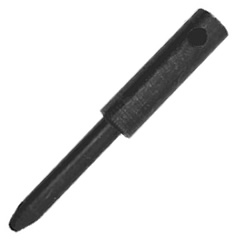
Alignment pins are commonly used to align and position workpieces. Also known as locating pins, they are manufactured to strict standards. Alignment pins feature specific dimensions, allowing for a precise fit in the hole with which they are used. There are several different types of alignment pins, however, each of which features a unique design.
Shoulder Alignment Pins
Shoulder alignment pins are characterized by a wider handle diameter relative to that of the pin body. The handle is essentially a shoulder because it’s wider than the pin body.
The handle is the top part of an alignment pin, whereas the pin body is the bottom part that’s inserted into a hole. The photo above depicts a typical shoulder alignment pin. As you can see, the handle is wider than the pin body.
T Alignment Pins
T alignment pins receive their namesake from their T-shaped design. They still feature a pin handle and pin body, and they are used for many of the same alignment and positioning applications as their shoulder counterparts. T alignment pins simply feature a T-shaped design.
With their T-shaped design, T alignment pins are ergonomic. You can easily grip them with one hand to remove them.
L Alignment Pins
While some alignment pins feature a T-shaped design, others feature an L-shaped design. L alignment pins are ergonomic and easy to grip as well. The handle of an L alignment pin, however, creates a 90-degree angle with the pin body.
Some people prefer T alignment pins, whereas others prefer L alignment pins. The only real difference between these two styles lies in their handle. T alignment pins feature a perpendicular handle that extends across the top of the pin body. L alignment pins, in comparison, create a 90-degree angle with the pin body.
Why Does the Handle Have a Small Hole?
Whether you’re shopping for a shoulder alignment pin, T alignment pin or L alignment pin, you may notice that it has a small hole in the handle. Most alignment pins don’t have a completely solid handle. Rather, they are designed with a small hole in the handle.
The purpose of the handle hole is to accommodate a cable. You can always remove alignment pins manually by gripping and pulling them out with your hand. Alternatively, you can connect a cable to them. Placing a cable through the handle hole of an alignment pin will allow you to remove it by pulling the cable.
